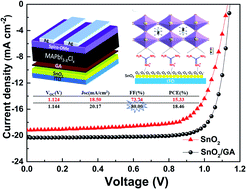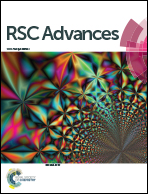Effect of guanidinium chloride in eliminating O2− electron extraction barrier on a SnO2 surface to enhance the efficiency of perovskite solar cells†
Abstract
Owing to their low cost, easy fabrication and excellent chemical stability properties, tin dioxide (SnO2) nanoparticles have been widely employed as an electron transfer material in many high-efficiency perovskite solar cells (PeSCs). However, the adsorbed oxygen species (i.e. O2−) on the surface of the SnO2 layer, which are induced by the annealing process under ambient environment, have always been overlooked. In general, the adsorption of oxygen creates an energy barrier at the SnO2/perovskite interface, impairing the efficiency of PeSCs. In this work, by using guanidinium (GA) chloride to modify the SnO2 surface, we have successfully improved the power conversion efficiency (PCE) of PeSCs from 15.33% (no GA-modification) to 18.46%, with a maximum fill factor of 80%. The performance enhancement is mainly attributed to the reduced energy barrier at the SnO2/perovskite interface due to the strong coupling between the GA and the adsorbed oxygen, which has been supported by the FTIR and XPS results. The strategy of reducing the charge extraction barrier by GA modification has been demonstrated to be an efficient approach to improve both the PCE and stability.



 Please wait while we load your content...
Please wait while we load your content...